The Agapanthus is endemic to southern Africa where it is one of the best known garden plants. In this article, we’ll explore the Agapanthus species and their growing conditions, the uses of the plant and how it got its name.
More...
Genus: | Agapanthus |
|---|---|
Common Names: | Lily of the Nile, African lily |
Family: | Amaryllidaceae |
Location: | Indoor or outdoor |
Type: | Herbaceous perennial |
Growth: | Can grow up to 2.4 metres in height and up to 92 cm in width |
Sun requirements: | Full sun |
Foliage Colour: | Green |
Flower Colour: | Blue, purple, white, pink |
Flowering: | Summer |
Maintenance level: | Low |
Poisonous for pets: | No |
Getting to Know Agapanthus

Agapanthus are popular throughout the world, and some have been cultivated in Europe since the late 17th century.
It consists of six species:
- Two evergreen species: A. africanus and A. praecox
- Four deciduous species: A. campanulatus, A. caulescens, A. coddii and A. inapertus.
Also known as the African lily, the Agapanthus flowers during the summer, with blooms in shades of blue and purple, and also white and pink.
Some of the cultivars include:
- Blue Agapanthus: African Skies, Black Pantha, Northern star, Pretty Sandy, Queen mum, Sweet Surprise
- Purple Agapanthus: Black Magic, Indigo Dreams, Royal Velvet
- White Agapanthus: Blue ice, Bridal Bouquet, Silver Baby, Snow Crystal, Snow Pixie, Strawberry Ice, Twister
The name Agapanthus comes from the Greek agape which means love and anthos, which means flower. It could therefore be interpreted as 'lovely flower' or 'flower of love'.
Agapeo means 'to be contented with' so again, the meaning of Agapanthus could also be 'flower with which I am well pleased'.
Lily of the nilehas earned a few common names over the years. It was first known in Europe as the African hyacinth and more recently as the African lily or Lily of the Nile. In South Africa they are commonly called agapanthus or bloulelie.
Uses of African Lily
The Agapanthus is sometimes called magical because of its medicinal properties.
Xhosa women use the roots to make antenatal medicine and the Zulu use Lily of the nile to treat heart disease, paralysis, coughs, colds and chest pains. It can also be used with other plants in medicines taken during pregnancy to ensure a healthy baby, and to induce labour.
Hikers have been known to put the leaves in their shoes to soothe their feet and to wrap weary feet in the leaves for half an hour. The long and strap-like leaves make an excellent bandage and winding leaves around the wrists can apparently help bring a fever down.
Agapanthus has anti-inflammatory properties and is also anti-oedema, relieves coughing and can help regulate the immune system.
Agapanthus Varieties
Agapanthus africanus
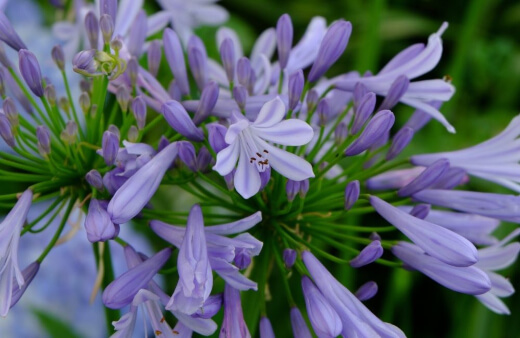
Common names: Cape Agapanthus, Fynbos Agapanthus
Subspecies: Africanus and Walshii


Get Your Free Guide:
Master Growing Australian Natives eBook
A Must Have Complete Guide for Every Australian Garden
Get Your Free Guide:
Master Growing Australian Natives eBook
A Must Have Complete Guide for Every Australian Garden
*Includes the Peter Pan and Tinkerbell cultivars*
Where to Grow Fynbos Agapanthus
A. africanus usually grows in a winter rainfall area, in mountainous terrain and acidic sandy soil. They often grow between rocks. These plants cannot handle freezing weather for any length of time.
How to Grow Agapanthus africanus
Both subspecies of A. africanus are difficult to grow. If planted in a garden, they would need to be in a rockery. They are best grown in containers in a well-drained, slightly acidic sandy mix and are in fact happiest in a pot.
They seem to grow best in shallow containers and if you want them to flower regularly, you can feed the plant with a slow release fertiliser.
If you are planning to pot an Agapanthus for your balcony garden, have a look at our recommendations for the best plants for this kind of growing environment.
Cape Agapanthus Propagation
Both subspecies of A. africanus can be propagated by fresh seed. The seed germinates well if it’s sown in a well-drained seed mix and lightly covered.
The seed trays need heat and a mist spray for about five minutes twice a day. Germination happens in 4 to 6 weeks and the trays then need to move to a lightly shaded area. This can be indoors or outdoors and water twice a day.
Agapanthus campanulatus
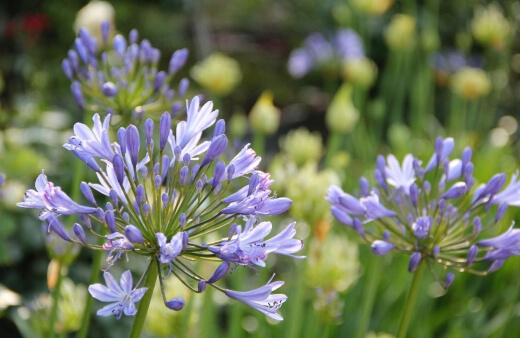
Common names: Bell Agapanthus
Where to Grow Bell Agapanthus
This species of Agapanthus is a good choice for gardeners in cold areas who struggle to grow evergreen Lily of the nile. A. campanulatus likes to grow in colonies in moist grassland, moist slopes, valley bottoms, drainage lines, damp cliffs and on rocky slopes up to 2400 metres.
Fruit and flowers
A. campanulatus is deciduous and produces pale to deep blue flowers with a darker blue stripe. The anthers are a blue colour as well - this is because the pollen is lilac in colour, a trait that it shares with A. caulescens and A. coddii. The fruit of the plant is a capsule containing many flat, black, winged seeds.
Subspecies
A. campanulatus has two subspecies. A. campanulatus subsp. campanulatus has flower tubes that are longer and the outer lobes spread less than those of A. campanulatus subsp. patens.
Uses
Its roots are often crushed and made into a lotion that is used to bathe newborn babies and the leaves are used to wash young babies. It is also used to treat 'cradle caps'.
How to Grow Agapanthus campanulatus
This Agapanthus species is perfect for big floral displays and makes a good groundcover in light shade under trees for example. It can also be planted in clumps to create a herbaceous border.
A. campanulatus is ideal for pot cultivation and as a cut flower too. You could use whole flower heads or individual flowers in small arrangements.
Agapanthus caulescens
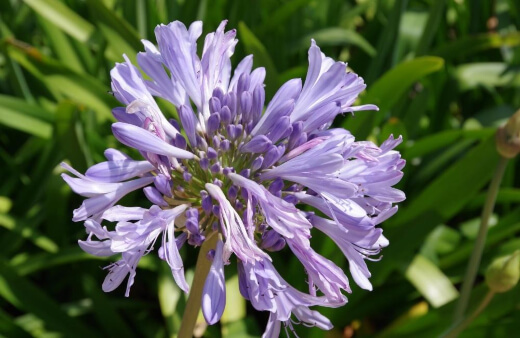
Common name: Stem Agapanthus
This is definitely one of the most beautiful species in the Lily of the nile family. It might be beautiful but it’s also unknown as a garden plant because you can’t really get it from nurseries.
Where to Grow Stem Agapanthus
The plant is deciduous and usually found in summer rainfall areas, but also in places where the temperature drops below 0°C in winter and where it may snow.
The stem agapanthus becomes dormant in winter, so it’s unaffected by the winter rains if planted in a well-drained site. There are three subspecies.
How to Grow Agapanthus caulescens
A. caulescens is easy to grow and can be split to increase the planting stock. The best time to divide the plant is in spring, just as it’s starting to sprout new leaves. It can also be split during the growing season but never during winter.
Flowering
A. caulescens isn’t really known outside botanic gardens but it really is a magnificent free flowering plant. The flowers range in colour from dark to light blue.
What’s interesting is that all Agapanthus flowers which are dark blue/purple will fade in colour when placed indoors.
Agapanthus coddii

Source: rhs.org.uk
Common names: Waterberg Agapanthus, Codd's Agapanthus
A. coddii is one of the lesser known variety. It is deciduous – it loses all its leaves in autumn, becomes dormant during the winter months and produces a new set of leaves in the spring.
How to Grow Waterberg Agapanthus
It’s easy to grow and likes full sun. The plant is not at its best in semi-shade but will still do well in light shade for about half the day.
In order to get A. coddii to flower well, it needs to be fed generously every spring and watered well during spring and summer. Plant A. coddii so that the rootstock is just underground.
A. coddii is a good companion for winter growing plants. It is also suitable for pot cultivation but it is a bit big. It would need regular supplementary feeding and a large container to grow in.
If you’re feeling inspired to maybe grow an Agapanthus in your office (because who wouldn’t want to look at those gorgeous flowers every day), have a look at our benefits and care guide for the best office plants in Australia.
Agapanthus praecox
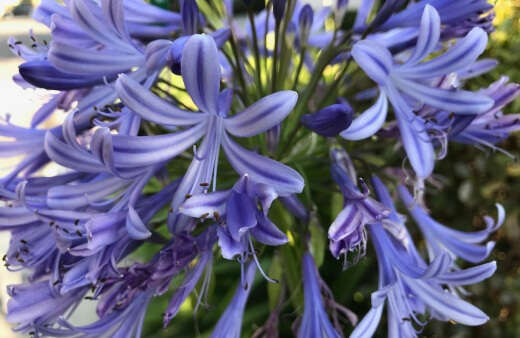
Common names: Common Agapanthus, Blue lily
*includes Black Pantha and Queen Mum varieties*
How to Grow Blue Lily Agapanthus
A. praecox is easy to grow and can handle the poorest of soils. As with most plants, they do well with weekly deep drenching instead of a sprinkling of water more often. It prefers full sun, but some cultivars will flower in semi-shade.
All the evergreen Lily of the nile should be lifted and divided every four years to ensure flowering. A. praecox can handle light frost. In areas with extreme winter temperatures, they would do better in containers that can be taken into a greenhouse during winter or a similar type of indoor setting.
Where to Grow Common Agapanthus
This species is the perfect plant to stabilise a bank and to prevent erosion. In a difficult seaside garden, they can even stand up to the wind.
Agapanthus inapertus
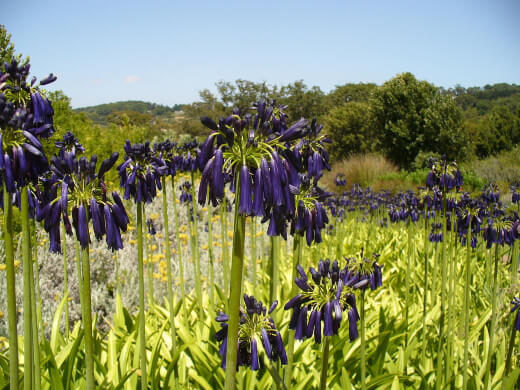
Source: en.wikipedia.org
Common names: Drakensberg Agapanthus, Drooping Agapanthus
Where to Grow Drakensberg Agapanthus
The deciduous A. inapertus is the perfect choice for a summer rainfall water-wise garden. This species is also suitable for cold areas as it will not be affected by frost. It actually prefers the cold and won’t do well in warmer parts of the country.
Flowering
A. inapertus has flowers that hang loosely (thus the name drooping agapanthus) and almost look like a cluster of bells. The flowers vary in colour from white to almost navy blue.
How to Grow Agapanthus in Australia

This plant is quite easy to cultivate and once it’s established, a little love and attention now and then is sufficient. What we love is that they grow strong and are generally pest free.
These plants are a favourite for plant borders or to grow in containers. The flowers are loved by bees and the flower seeds are dispersed by wind.
Most of the Agapanthus varieties are easy to grow except for Agapanthus africanus and its subspecies Agapanthus walshii.
What Soil to Use
They grow well in most soils, but their ideal is a rich, well drained, composted soil and plenty of water in summer. It can handle irrigation during its winter dormant period and does well in winter rainfall, as long as it is planted in well-drained soil.
Sun Requirements
Lily of the nile should be planted in full sun to produce the best floral displays but it can also do just fine with partial shade.
Ideal Climate
Lily of the nile knows how to handle frost and should be able to survive outdoors in areas with a winter minimum of -7°C. In regions that dip to -5°C and below for long periods, the plants should be mulched with a think protective layer – you can use leaves, straw or hessian.
Agapanthus Propagation
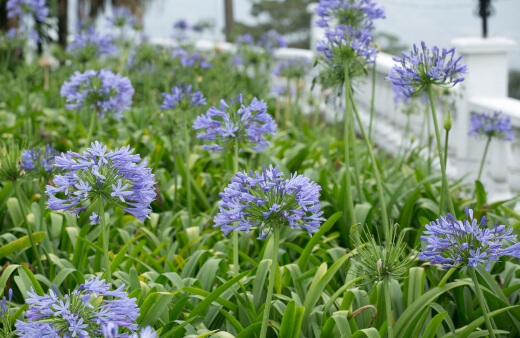
Propagation is by seed or division. Agapanthus hybridise freely with each other. They all flower at the same time and you will definitely find hybrids from seeds harvested in the garden.
Propagating Agapanthus from Seeds
Agapanthus are easy to propagate from seed. However, seeds have a limited lifespan and are best sown as fresh as possible. Seeds can be sown fresh in late summer/autumn.
If you’re living in a cold climate, the seed can be kept refrigerated and sown in spring. You do need to keep it in the fridge otherwise it will die. Sow the seed in deep 10 cm trays, using a mixture of equal parts river sand and fine compost. Keep the seedling semi-shaded and moist.
The seed usually germinates within six to eight weeks. Remember that the seedlings will stay in the tray for their first year so don’t plant too many in the same container.
In their second year, the seedlings can move into individual containers and can be planted into the garden or permanent pots in their third year. Flowering will take place from their third or fourth year.
Caring for Agapanthus Plant

To keep looking its best, feed it well every spring and water well during spring and summer.
Optimal flowering
The evergreen varieties need to be lifted and divided every four years to ensure optimal flowering. When it comes to maintaining your Lily of the nile, clumps can be lifted and divided in spring just before active growth begins.
Try not to lift them too often as this will negatively impact their flowering. Agapanthus usually flower best in their first season after dividing.
You need quite a bit of strength to lift and divide large clumps. Our advice is to place two garden forks back to back in the centre of the clump and then pull them apart.
The clump can also be chopped up with a spade. Aim to reduce the length of the foliage by one half and reduce the roots by two-thirds. You need to replant the Lily of the nile immediately and water it well.
Agapanthus campanulatus, and all the other deciduous species, need a time of settling in so they might not flower very well in their first year after being replanted. Our advice is to leave them undisturbed for up to six years.
Fertilising Agapanthus
Seedling and adult Lily of the nile plants love composted soil and a slow release fertiliser.
Lily of the Nile Pests and diseases

Generally, Agapanthus are pest free and will outgrow most problems. Snout beetles can cause damage but you can find a cure for these pests at most nurseries.
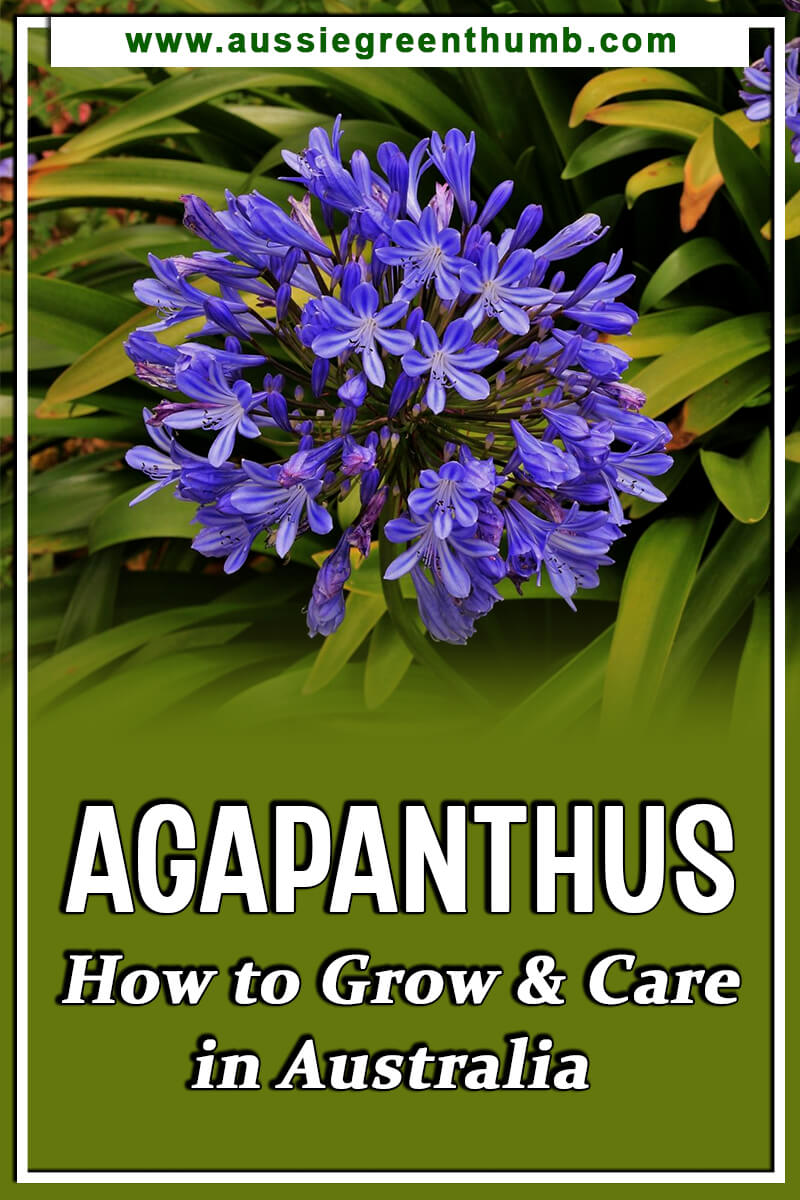
Wrapping Up Our Agapanthus Guide
The Lily of the nile has travelled far from its South African roots, to make a new home in many parts of the globe, Australia included. With so many varieties and floral shades, you might find it hard to decide which one to grow – do you like a pink palette, or deep shades of blue and purple, or just pure white.
It’s a fairly low maintenance plant, hardy, but also a bit of a charmer. The Greek name inspiration as the ‘flower of love’ seems apt for the African lily. We are giving the Agapanthus our green thumbs up!
Published on March 10, 2022 by Maisie Blevins
Last Updated on February 21, 2025




